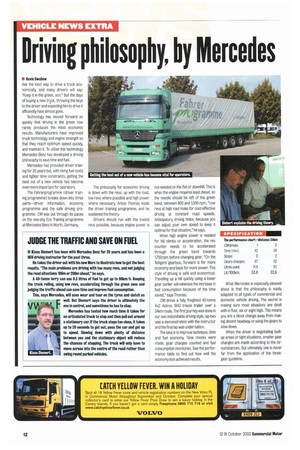Driving philosophy, by Mercedes
Page 14

If you've noticed an error in this article please click here to report it so we can fix it.
• Kevin Swallow Ask the best way to drive a truck economically, and many drivers will say: "Keep it in the green, son." But the days of buying a new truck, throwing the keys to the driver and expecting him to drive it efficiently have almost gone.
Technology has moved forward so quickly that driving in the green now rarely produces the most economic results. Manufacturers have improved truck technology and engine strength so that they reach optimum speed quickly, and maintain it. To utilise this technology Mercedes Benz has developed a driving philosophy to save time and fuel.
Mercedes has provided driver training for 30 years but, with rising fuel costs and tighter time constraints, getting the best out of a new vehicle has become even more important for operators.
The Fahrerprogramme (driver training programme) breaks down into three parts—driver information, economy programme and the safe driving programme. CM was put through its paces on the one-day Eco Training programme at Mercedes Benz in Worth, Germany. The philosophy for economic driving is down with the revs, up with the load, low revs where possible and high power where necessary. Anton Thomas leads the driver training programme, and he explained the theory.
Drivers should run with the lowest revs possible, because engine power is not needed on the flat or downhill. This is when the engine requires least diesel, so the needle should be left of the green band, between 800 and 1,000 rpm. "Low revs at high toad make for cost-effective driving at constant road speeds. Anticipatory driving helps, because you can adjust your own speed to keep it optimal for that situation," he says.
When high engine power is needed for hill climbs or acceleration, the rev counter needs to be accelerated through the green band towards 1,700rpm before changing gear. "On the Telligent gearbox, forward is for more economy and back for more power. This style of driving is safe and economical. Travelling up a hill quickly using a lower gear earlier will minimise the increase in fuel consumption because of the time saved," says Thomas.
CM drove a fully freighted 40-tonne 4x2 Actros 1843 triaxle trailer over a 34km route. The first journey was done in our own indomitable driving style, lap two was a demonstration with the instructor and the final lap was under tuition.
The idea is to improve technique, time and fuel economy Time checks were made, gear changes counted and fuel consumption monitored. See the performance table to find out how well the economy test achieved results. What Mercedes is especially pleased about is that the philosophy is easily adapted to all types of commercial and domestic vehicle driving. The secret is making sure most situations are dealt with in four, six or eight high. This means you are a block change away from making decent headway or using the gears to slow down.
When the driver is negotiating builtup areas or tight situations, smaller gear changes are made according to the circumstances. But ultimately one is never far from the application of the threegear guideline.












































































































